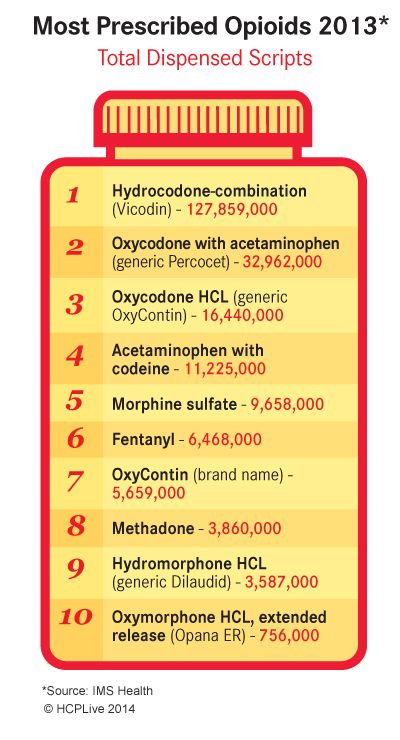Article
Top 10 Painkillers in the US
Author(s):
As part of federal efforts to curb prescription drug abuse, the US Drug Enforcement Agency (DEA) is reclassifying hydrocodone-combination drugs (Vicodin/AbbVie) as a schedule 2 controlled substance. But even if the tighter controls mean some doctors will switch appropriate patients to schedule 3 drugs, like acetaminophen with codeine, alternative painkillers have a long way to go to topple the market leader, according to data from IMS Health.
Introducing Painkiller: A History of Crisis
As part of federal efforts to curb prescription drug abuse, the US Drug Enforcement Agency (DEA) has reclassified hydrocodone-combination drugs (Vicodin/AbbVie) as a schedule 2 controlled substance.
That will mean physicians will no longer be able to write prescriptions for a 6-month’s supply, but will be limited to half that. Patients will now have to go to a physician’s office at least every 90 days to get a new prescription.
“That could mean a decrease in hydrocodone-combination sales—that’s probably why there was resistance from the drug companies--but for most doctors it won’t be that big deal,” said Mark Melrose, MD, commenting on the switch to schedule 2. Melrose is an emergency medicine specialist who is a partner in Urgent Care Manhattan, a two-location walk-in emergency care practice in New York City.
“If there’s a legitimate need for a patient to get Vicodin, why wouldn’t you prescribe it?” he said.
“Even when it was class 3, we still had to follow up with a written prescription and look up a patient on the prescription drug registry,” something most states have now, he said.
But even if the tighter controls mean some doctors will switch appropriate patients to schedule 3 drugs, like acetaminophen with codeine, alternative painkillers have a long way to go to topple the market leader, according to data from IMS Health.
Check out MD Magazine's coverage of the 2017 list of top drugs by spend.

1. Hydrocodone-combination (Vicodin): 127,859,000 prescriptions
2. Oxycodone with acetaminophen (generic Percocet): dispensed through prescriptions 32,962,000 times.
3. Oxycodone HCL (generic OxyContin): 16,440,000 prescriptions.
4. Acetaminophen with codeine: 11,225,000 prescriptions.
5. Morphine sulfate: 9,658,000 prescriptions.
6. Fentanyl: 6,468,000 prescriptions.
7. Brand-name OxyContin: 5,659,000 prescriptions. Adding that total to its generic equivalent would not change the drug’s third-place ranking.
8. Methadone: prescribed 3,860,000 times, a drop of 4,090,000 prescriptions in the preceding year.
9. Hydromorphone HCL (generic Dilaudid): 3,587,000 prescriptions.
10. Oxymorphone HCL, extended release (Opana ER): with 756,000 prescriptions. Endo Pharmaceuticals has since removed the drug from the market after the US Food and Drug Administration (FDA) submitted a withdrawal request for the injection pain treatment, saying that it's risks outweighed it's benefits.
The DEA change is part of mounting concern about a national epidemic of prescription drug abuse. Earlier this year, the US Centers for Disease Control and Prevention (CDC) released a study showing that there is a wide variation in opioid prescribing patterns across the nation.
For instance, doctors in Alabama prescribed 142.9 opioid prescriptions for every 100 population, while doctors in New York prescribed only 59.5 such prescriptions for every 100 population.
But doctors in Maine prescribed the most long-acting extended release opioid pain-relievers, and physicians in Delaware prescribed high-dose opioids at the highest ate. Only two states were in the top 10 for all 3 categories, Tennessee and West Virginia.The CDC study used IMS data for 2012.
The more recent IMS data provided to HCPLive.com show that since then, total sales of codeine and codeine-combination drugs have dropped from 212,009.000 in 2012 to 201,493,000 in 2013.
Sales of morphine and opium derivatives rose to 22,329,000 in 2013 from 22,033.000 in 2012.
IMS, a commercial service, obtains its data from wholesalers.





